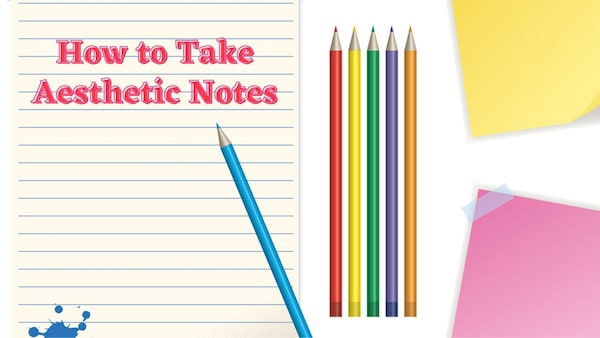In today’s digital age traditional methods of handwritten note-taking still hold a special place in our hearts. However, note-taking doesn’t have to be a mundane task. With a little creativity and attention to aesthetics, you can transform your notes into visually appealing works of art.

In this article, we will explore how to take aesthetic notes. Various ideas and techniques to help you take aesthetic notes that are both visually pleasing and functional. Let’s first understand how to take aesthetic notes and best note-taking ideas.
Table of Contents
How to Take Aesthetic Notes: Best Note-taking Ideas
1. Choosing the Right Materials:
To take aesthetically pleasing notes start by selecting quality materials. Invest in a good notebook with smooth high-quality paper that will enhance the writing experience.
Consider using colored pens fine-point markers or even fountain pens to add depth and vibrancy to your notes. You can also experiment with different paper textures such as dotted or grid lines to create a visually interesting layout.
2. Incorporate Visual Elements:
Visual elements play a crucial role in making your notes visually appealing. Include sketches doodles or diagrams related to the content of your notes.
These visual aids can help you understand and remember information better while adding personality to your notes. You don’t need to be a skilled artist – simple illustrations and icons can still greatly enhance the overall aesthetics.
3. Color Coding:
Color coding is an effective technique for organizing your notes and making them visually pleasing. Assign different colors to different types of information topics or themes.
For example, use one color for headings another for key points, and a different color for examples or supporting details. This visual hierarchy will not only make your notes look stylish but will also make them easier to review and understand.
4. Hand Lettering and Typography:
Experimenting with different lettering styles and typography can elevate your note-taking game. Practice hand lettering techniques like calligraphy or brush lettering to add flair to your headings and titles.
Alternatively, you can mix different fonts and font sizes to create visually striking text. However, be mindful of legibility and make sure your notes remain easy to read.
5. Use Washi Tapes and Stickers:
Washi tapes and stickers are fantastic tools to bring a pop of color and decoration to your notes. Use washi tapes to frame sections create borders or highlight key information.
Stickers can add a playful touch and help you emphasize important concepts. It’s essential to find a balance between functionality and aesthetics – use these decorative elements purposefully and sparingly to avoid overwhelming your notes.
6. Mind Maps and Conceptual Diagrams:
Organize your notes using mind maps or conceptual diagrams. These visual tools aid in structuring your thoughts and making connections between different ideas.
Mind maps can be created on a separate sheet of paper or integrated directly into your note pages. Use different colors symbols and lines to visually represent relationships and hierarchy within your notes.
7. Consistency and Layout:
Consistency in formatting and layout is key to achieving aesthetically pleasing notes. Establish a structure that works for you and maintain it throughout your note-taking process. Use a grid system to align your text headings and visual elements.
Incorporate whitespace to provide clarity and improve readability. Aim for a balanced and harmonious layout that showcases your information effectively.
8. Personal Touch:
Infuse your personality into your notes to make them uniquely yours. Incorporate your favorite quotes stickers or small sketches that reflect your interests and style. Adding personal touches not only makes note-taking enjoyable but also encourages you to engage with the material more deeply.
Creating aesthetic notes is a delightful way to make your learning experience more engaging and enjoyable. By implementing the ideas and techniques mentioned above you can transform your ordinary notes into visual masterpieces.
Remember the ultimate goal is not just aesthetics but also effective organization and comprehension. Experiment have fun and let your creativity flow as you embark on your journey of aesthetic note-taking.
How to Choose a Style for Aesthetic Notes: Ideas for Designing Beautiful and Inspiring Note-taking
In this digital age where technology provides us with endless tools for note-taking, there is still something charming and inspiring about handwritten notes. Aesthetic notes go beyond mere functionality; they add a touch of creativity and beauty to the task of capturing information.
Whether you are a student professional or an avid learner embracing the art of aesthetic note-taking can enhance your learning experience and make the process more enjoyable.
But how do you choose a style for your aesthetic notes? With countless options and creative ideas available, it can be overwhelming to know where to start.
In this article, we will explore some tips and inspiration to help you choose a style that resonates with your personality and enhances your note-taking experience.
1. Determine Your Purpose:
Before embarking on designing aesthetic notes it’s essential to understand the purpose behind your note-taking.
Are you a student looking to enhance your study materials? Or are you a professional who wants to create visually appealing meeting minutes?
Knowing your purpose will help guide you in selecting a style that aligns with your goals and enhances your workflow.
2. Explore Different Aesthetic Styles:
One of the exciting aspects of aesthetic note-taking is the endless range of styles you can choose from. Spend some time exploring various aesthetic styles such as minimalistic vintage floral modern or even a combination of different elements.
There are several online platforms social media accounts and Pinterest boards dedicated to providing inspiration and ideas for aesthetic note-taking. Take advantage of these resources to explore different styles and identify what resonates with you.
3. Reflect on Your Personality and Learning Style:
Your notes should reflect your unique personality and learning style. Are you someone who prefers clean lines and minimalistic designs? Or do you enjoy vibrant colors and intricate patterns? Consider your preferences and think about how you learn best.
Some individuals find visual aids and diagrams more helpful while others prefer written summaries and bullet points. Incorporate elements that align with your learning style to create effective and aesthetically pleasing notes.
4. Experiment with Color Schemes:
Color plays a crucial role in creating visually appealing notes. It can evoke emotions enhance memory retention and make your notes more engaging. Experiment with different color schemes that align with your style and the subject matter you are studying.
For example, if you are studying biology or nature-related topics consider incorporating earthy tones or shades of green.
If you prefer a more vibrant and energetic feel opt for bold and contrasting colors. Remember to use colors strategically to highlight important information and create a visual hierarchy within your notes.
5. Incorporate Visual Elements:
Aesthetic note-taking is not limited to just text. Integrate visual elements such as illustrations doodles icons or images to make your notes visually appealing and memorable. These visual aids can help simplify complex concepts or make connections between different ideas.
They also add a personal touch to your notes and enhance your creative expression. Experiment with different drawing techniques such as sketching hand lettering or watercolor to find what suits your artistic abilities and style.
6. Prioritize Organization and Clarity:
While designing aesthetic notes it’s crucial to maintain organization and clarity. Avoid overcrowding your notes with excessive decoration or complex layouts that may distract from the content. Remember the primary purpose of note-taking is to capture and retain information effectively.
Utilize proper headings subheadings and bullet points to create a clear hierarchy of information. Balance creativity with practicality to ensure that your notes remain functional and easy to navigate.
7. Seek Inspiration from Others:
Don’t hesitate to seek inspiration from other individuals who excel in aesthetic note-taking. Follow social media accounts or join communities where people share their creative note-taking ideas.
Seeing what others have created can spark new ideas and broaden your creative horizons. However, make sure to give credit where it’s due and use others’ work as inspiration rather than copying directly.
Remember note-taking should be a dynamic and personal process. Let your creativity flow and enjoy the journey of designing aesthetic notes.
Embrace the process of self-expression and discovery as you develop your unique style. With practice your aesthetic notes will become not only a tool for learning but also a beautiful representation of your unique perspective and creativity.
How to Structure Aesthetic Notes to Boost Creativity and Organization
Taking notes is an essential part of our lives whether it’s for work studying or personal projects. But why settle for plain and mundane notes when you can add a touch of creativity and aesthetics to make the process more enjoyable and memorable?
Aesthetic notes not only enhance the overall visual appeal but also stimulate creativity and boost information retention. In this article, we will explore some ideas and practical tips on how to structure aesthetic notes effectively.
1. Choose the Right Tools
Before delving into the structure and design of aesthetic notes it is crucial to select the right tools. Consider using a notebook or sketchbook with quality paper that can handle various mediums like pens markers or watercolors.
Additionally, invest in colorful pens highlighters stickers washi tapes, and other decorative elements that align with your personal style.
2. Define a Consistent Theme
To create visually appealing aesthetic notes it’s essential to define a consistent theme or style throughout your notebook or study materials.
Choose a theme that resonates with your personality and interests whether it’s minimalist floral vintage or futuristic. This will give your notes a distinct visual identity and make the overall experience more enjoyable.
3. Use a Hierarchy in Organization
Organization is the key to effective note-taking. When structuring your aesthetic notes incorporate a hierarchical structure that allows for easy navigation and quick information retrieval.
Start with an overarching title or topic at the top of the page followed by subheadings bullet points and indents for different levels of information. This hierarchical structure will help you identify the main ideas and supporting details at a glance.
4. Incorporate Visuals and Illustrations
One of the distinctive features of aesthetic notes is the integration of visuals and illustrations. Include diagrams charts mind maps and doodles to reinforce concepts visually.
Visual aids not only enhance the aesthetic appeal but also help in capturing information more efficiently and memorizing it effectively. Experiment with different drawing styles typography and color combinations to add a unique touch to your notes.
5. Embrace Calligraphy and Hand Lettering
Calligraphy and hand lettering are great ways to add a touch of elegance and creativity to your aesthetic notes. Explore different calligraphy styles and lettering techniques to make headings titles and important points stand out.
Practice stroke formation and experiment with various pens and brush pens to find the style that suits you best. A well-executed calligraphy or hand-lettered quote can instantly elevate the visual appeal of your notes.
6. Play with Color Palettes
Color plays a significant role in aesthetic notes as it can evoke emotions and enhance information retention. Create a color palette that complements your chosen theme or subject.
Use colors strategically to aid in organizing information highlighting key points or categorizing related concepts. Experiment with color combinations gradients and shading techniques to bring vibrancy and visual interest to your notes.
7. Don’t Overcrowd the Pages
While it’s tempting to fill every inch of your notebook or study materials with designs and decorations it’s important to strike a balance and avoid overcrowding. Leave enough white space on the page to maintain clarity and readability.
White space also helps in drawing attention to important information and prevents the notes from looking cluttered. Remember simplicity can be equally impactful and aesthetically pleasing.
8. Add Inspiring Quotes and Mindful Reflections
Incorporating inspiring quotes and personal reflections can infuse a sense of purpose and motivation in your aesthetic notes. Select quotes that resonate with your subject matter or ones that inspire you to stay focused and driven.
Dedicate a section of your notes for reflections jotting down key takeaways or brainstorming creative ideas. This will not only enhance the aesthetic appeal but also make your notes more personalized and meaningful.
Conclusion
We now hope you have a better understanding of how to take aesthetic notes. By incorporating aesthetics into your note-taking process you can transform an ordinary task into a creative and enjoyable endeavor.
The structured organization of visual elements and creative touches of aesthetic notes not only enhance information retention but also stimulate your creativity and bring joy to the learning process. So grab your pens unleash your imagination and start creating notes that are as visually pleasing as they are useful!
Also Read:



